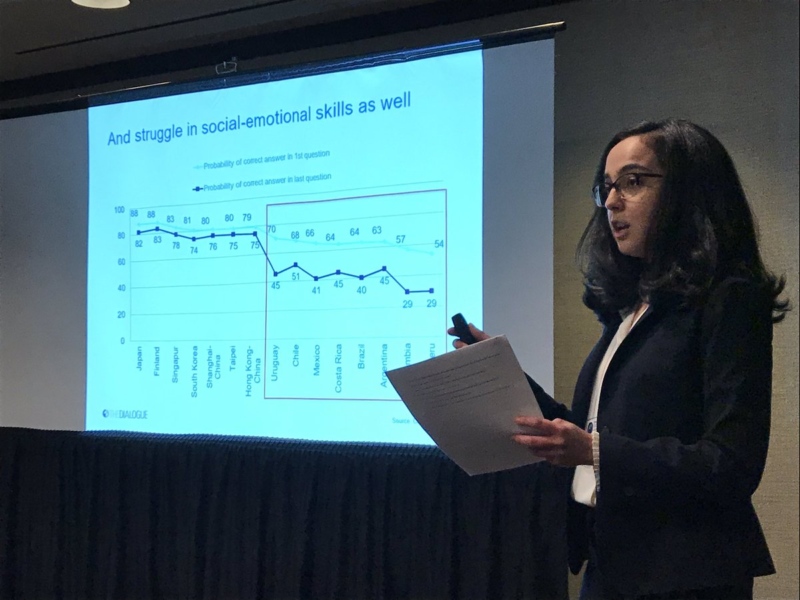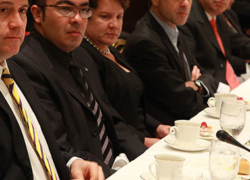The Dialogue presents on technical education at CIES Conference
 Credits: Jim Hahn, FHI 360
Credits: Jim Hahn, FHI 360
At the Comparative and International Education Society (CIES)’s 67th Annual Conference held this week in San Francisco, the Dialogue’s Maria Oviedo presented findings from the Education Program’s recent report: Technical Education and Professional Training in Latin America and the Caribbean (available in Spanish).
CIES is the world’s largest and oldest international education society in the world. This year’s annual conference boasted over 3,600 attendees from 125 countries. The Dialogue’s work was featured in a panel titled “Understanding and Overcoming Barriers to Technical Education in Latin America and the Caribbean,” where Maria Oviedo joined practitioners from FHI 360, USAID and Jamaica’s Vocational Training Development Institute.
HIGHLIGHTS FROM THE PRESENTATION
The Dialogue’s presentation centered on some of the challenges facing secondary and post-secondary education in the region, efforts to address these challenges through technical education and professional training, as well as challenges facing these efforts and opportunities for improvement.
The issues
The region’s secondary and post-secondary education systems struggle with issues of quality and relevance. Students at these levels are not graduating with the skills they need to be successful in today’s labor markets. Latin American countries all placed in the bottom third among participating countries in the 2015 PISA Evaluation, the largest standardized student learning evaluation in the world. Additionally, some studies point to low socioemotional skills among students in the region. Not surprisingly, employer surveys show that Latin American companies – more so than their counterparts in other regions – struggle to find qualified personnel. Latin America is the region of the world where it takes the longest amount of time (3.5 weeks) to fill a skilled position. There are also large gaps in access to post-secondary education among students from different socioeconomic backgrounds, and among those who do enter post-secondary education, about half drop out of school before graduating.
National efforts
In recent years, countries have made efforts to increase the quality and relevance of technical education and professional development to prepare young people with the skills they need to succeed.
National initiatives can be grouped into four categories:
- Rethinking what students learn: A number of countries have, in the past two decades, reformed secondary school curricula to focus less on rote learning and traditional subject areas, and more towards building competencies and skills. Additionally, some countries have attempted to add more social and emotional learning into curricula. These efforts are still in their nascent stages, but simply getting the language into curricula has been an important first step in Mexico, Brazil and Peru.
- Creating opportunities for vulnerable youth: To address the needs of the increasing number of students from low-income backgrounds who are now graduating from secondary education, countries have created a diverse range of financing mechanisms to ensure that students from all backgrounds have access to higher education. These take the form of scholarships, loans and stipends, and there is evidence that they do improve the likelihood of enrollment for these students. For the alarming number of students who never graduate from high school, training programs for out-of-school youth, commonly known as “Jóvenes” programs, combine classroom learning and on-the-job training and have been shown to be modestly effective at increasing employability, formality and income.
- Expanding technical education: Countries are increasingly recognizing the important role that technical education and professional training programs play at both the secondary and post-secondary levels, and have introduced mechanisms to promote enrollment. Costa Rica and Mexico, for instance, have introduced dual education programs based on the German model to make technical education both more valuable and attractive. In post-secondary education, countries seek to increase enrollment through creating new programs, developing scholarship programs specific to these programs, and setting up licensing and accreditation processes to ensure their quality.
- Improve knowledge of labor market trends: In order to bridge the gap that exists between employers, students and learning providers, and specifically to build student knowledge around labor market demands, many countries have created socio-occupational guidance programs that equip students with the information they need to make informed decisions about their education.
Challenges and opportunities
- Effective coordination among actors: Coordination between employers, training providers and the formal education system is crucial. Successful alliances and relationships among actors must be driven by market demands and opportunities for productive growth, such as through mechanisms to forecast future skills needs in the labor market. There is also a need for better articulation between education levels – for instance, by establishing clearer pathways between secondary and post-secondary school, and between technical post-secondary education and training and traditional higher education.
- Scaling up solutions: Many of the successful programs that currently operate are very small in scale, and scaling up is crucial to reaching the most disadvantaged students. When scaling solutions, aspects such as population size, student needs and labor market demands need to be kept in mind. For example, university scholarships for disadvantaged youth are more effective when paired with academic support programs that ensure students graduate successfully.
- More and better data: There are significant gaps in the availability and the quality of information on different types of programs. Importantly, we know socioemotional skills are critical to student success, but there is a lack of consensus on how to define or measure these skills – an area that requires greater research and investment.
There are many efforts underway to improve the quality and relevance of technical education and professional training programs. Going forward, the challenge will be to improve coordination between public and private actors, bridge information gaps regarding these programs, and scale them in order to reach the most disadvantaged populations in Latin America.



















